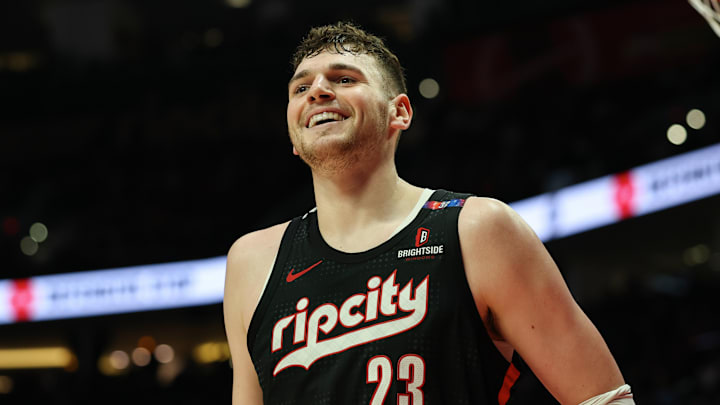A new NBA season will be upon us in the coming weeks, and the Portland Trail Blazers have plenty of exciting things on the horizon. Last year’s campaign showed promising signs down the stretch with a spate of concentrated player development occurring in the final months. One player that will be instrumental in any measurable Blazers success is Donovan Clingan, who is entering his sophomore season.
With Deandre Ayton’s contract buyout on June 29, Clingan’s future as the starting center of the Trail Blazers was all but cemented. All of Clingan’s 37 starts occurred in games where Ayton was unavailable due to injury, starting but playing just 24.5 minutes per contest.
Donovan Clingan enters Year 2 with something to prove
Clingan's Media Day press conference went a long way in addressing these concerns. A jovial Clingan looked noticeably thinner at the podium, saying he wants to play "at least" 30 minutes per game, while adding that his conditioning was the sole thing keeping him off the floor on a nightly basis. Despite these issues, Clingan still did an admirable job filling in for Ayton after he went down with a calf strain last February.
If you’re a casual viewer, “admirable” may describe the average Clingan viewing experience, because he appeared to have just a tenuous grasp on NBA offensive fundamentals. Dunks, putbacks, and a somewhat uninspiring outside shot were the de rigueur skills Clingan brought to the table in year one.
Defensively, Clingan’s output was another story; he blocked shots at a respectable clip and was an excellent rebounder. During an NBA Cup game, Clingan blocked eight shots against the Minnesota Timberwolves while grabbing 12 rebounds. The blocks were something of an aberration as Clingan swatted no more than four attempts in any other game, even as a starter.
With that said, the advanced stats, intangibles, and projected polishing of his game should get the fanbase excited about Clingan’s upcoming season.
Why Donovan Clingan is already underrated
In Clingan’s 37 starts, he averaged 2.1 blocks per game in his 24.5 minutes. In his games as Ayton’s backup, he averaged 1.1 blocks in 14 minutes. In terms of per-36 numbers, he swatted 3.1 shots per contest as a starter, and 2.9 as a bench player. This shows a tangible jump across just one year; Clingan averaged more blocks per-36 minutes against starting players than he did against second units.
The progression doesn’t stop there—among players who played as many minutes as Clingan, his BLK% was the second highest in the entire NBA at 7.5%, just behind Victor Wembanyama.
Though this number is high, it's somewhat negatively skewed by Clingan’s actual court presence. Unlike Wembanyama, Clingan operates as a drop big, meaning he patrols the paint looking to send shots away. While he excels at this, other players realize this as well.
When Clingan is in drop coverage, he disrupts plays by deterring would-be attackers; players will start a drive and hastily kick the ball out rather than face Clingan alone. This downshifts his BLK% by forcing the ball outside of the paint to a zone far away from him. To that end, he’s already one of the game’s greatest play disruptors.
Similarly, Clingan’s ORB% was second in the NBA at 17.3, meaning he secured 17.3% of all available offensive rebounds while he was in. Clingan effectively extended the possession on almost one-fifth of all missed shots, a number that will only become more impactful as his conditioning and stamina improve.
With Anfernee Simons gone, the Blazers will play a much more distributive brand of basketball that relies on movement far more than isolated shots, and Clingan excels in this role. While he wasn’t asked to do much passing in his rookie season, the flashes were there; however, his summer league highlights showcased his playmaking much more while operating in a more flexible, free-flowing offensive scheme.
The Blazers will play their first preseason game against the Warriors on October 8, where Clingan’s progression will be on full display.
